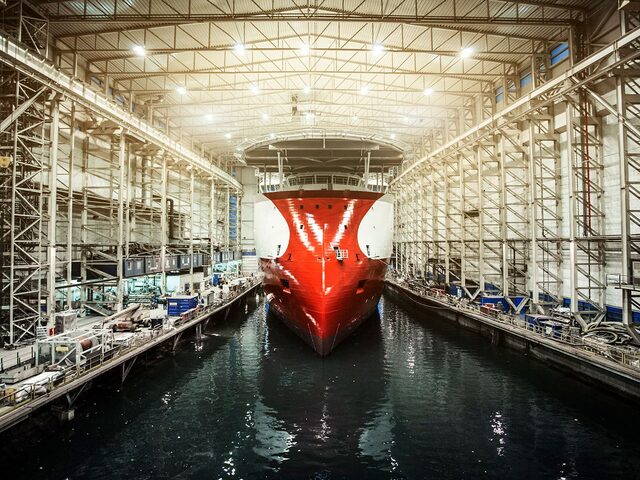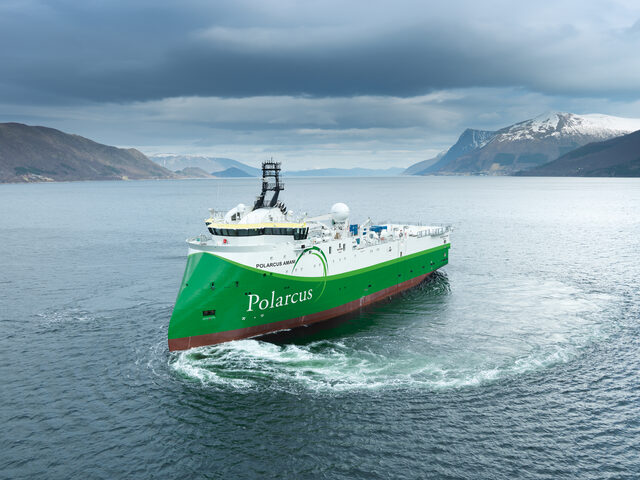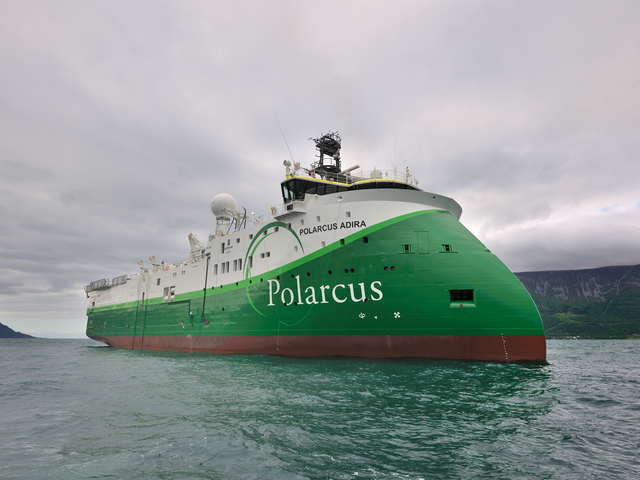Quality on time
Published
Thomas Konow at Polarcus has been sailing since he was 16, and during his career he envied the crew on X-BOW® vessels. In June he will finally go aboard one such vessel, the ‘Polarcus Adira’.
“I have sailed on several types of ships; roro vessels, passenger vessels and in later years, supply vessels. In the end, I grew tired of bad weather, and decided to go onshore in 2010,” Thomas says.
Today he is Technical Inspector – Newbuild at Polarcus and is following the construction processes of two new vessels at Ulstein Verft. The first, ‘Polarcus Amani’, was delivered in March. Konow will serve as Chief Officer on the second, ‘Polarcus Adira’, to be delivered in June.
According to Rolf Rønningen, CEO Polarcus, ULSTEIN’s strong international reputation for quality was a key factor in the company’s decision to build at ULSTEIN’s yard.
“We are happy to be building these ships at Ulstein Verft. Punctual, high-quality delivery is very important to us. Moreover, ULSTEIN has shown they can handle demanding building projects.”
Thomas Konow agrees: “When we see things that must be fixed, we contact the person in charge, and the next thing we know, it’s fixed. It’s as simple as that. Also, the yard is very good at learning from their mistakes to avoid repeating them. ULSTEIN has been through many high-tech building projects before and delivers on time, which is extremely important. Every day lost in delivery time is money lost,” he states, and continues:
“When people say it is dear to build in Norway, they need to study the whole cycle of the vessel. When you evaluate several factors like good dialogue in the building process, on-time delivery and a reduced need for service and repairs after delivery, the price tag a few months after delivery is comparable to anywhere else.”
Peter Zickerman, Executive Vice President of Polarcus, further notes that ULSTEIN’s high-value technical competence and innovative ship design was a good fit with Polarcus’ business philosophy.
“Together, we are developing the next generation seismic vessels incorporating state-of-the-art solutions. We are witnessing an increasing demand amongst our clients for higher quality, and more environmentally responsible seismic services,” he says. “The X-BOW hull design combined with a number of green and future-oriented solutions help us meet that demand with safer operations and better environmental performance.”
Ulstein Verft’s managing director Karsten Sævik appreciates their positive feedback:
“We have a highly competent workforce and a modern, world-class yard facility,” he says. “We are known for delivering vessels at the agreed price, quality and time, and these projects are no exception.”
"I am convinced already"
Back to Konow: “When I was working in the North Sea, I admired the passing X-BOW vessels, and I envied their crew. Our vessel experienced a lot of slamming, while the X-BOW vessels glided calmly by while going faster. I don’t need to be convinced of their benefits, I have seen it with my own eyes,” he states, and continues:
“The slamming makes your whole body tired. The calmer movements in X-BOW vessels have a big impact on the crew’s well-being.”
All vessels in Polarcus’ fleet are X-BOW vessels. That is a great competitive advantage, not least with regard to crew recruitment:
“One of the Polarcus vessels, the ‘Polarcus Naila’, worked for a period outside Northern Norway. In bad weather, she was the only vessel that could carry out crew change. The other vessels in the area were bobbing up and down in the sea. This is an important benefit for the crew,” Konow says.
“We are very pleased with all our vessels, their seakeeping abilities are very good. One of the vessels, the ‘Polarcus Alima’ was the first seismic vessel to sail the Northern Sea Route, in 2011.”
‘Polarcus Adira’ will operate outside Aberdeen, exactly in the same area where Konow previously worked. This being an X-BOW vessel, Konow is not worried. “It will be interesting to work on a seismic vessel for the first time. You cannot adjust the course according to the weather conditions, you have to carry on in a straight line, and that can be challenging as the tow is 1.4 kms wide and 8 kms long,” he says.
‘Polarcus Amani’ and ‘Polarcus Adira’ are the new generation ULSTEIN SX134s, carrying the ICE-1A* class notation from DNV, allowing for operations in arctic waters in heavy ice conditions without the assistance of icebreakers. The entire vessels are ice-reinforced with thicker ribs and skin plates. The vessels have de-icing and ice-preventing systems at critical tanks and pipelines. Propellers, gears and thrusters are chosen and dimensioned based on specific rules for withstanding operation in ice. The two propellers are driven by two electric motors each; this ensures continuous operation and manoeuvring if parts become damaged. In addition, the ships have the DNV notation WINTERIZED BASIC. Escape corridors and rescue equipment are also protected against icing during arctic operations. The vessels have two workboats and an MOB on board. The vessels are equipped for 3D seismic, with three additional lead-in winches on deck and two extra towing points adding up to 14 towing points in all (14 streamers). The additional winches provide added flexibility to enable personnel to easily replace or repair components during operations, avoiding costs related to downtime. The SPS code provides added safety and enables operations worldwide. The vessels also carry the Clean Design Certificate. The names of the new vessels are chosen with care, ‘Amani’ being an Arabic word, meaning ‘desires, aspirations, wishes’, and ‘Adira’, meaning ‘strong, mighty’.
Established in 2008, Polarcus will soon have a fleet of eight vessels, making them the fifth largest 3D seismic operator in the world. Their fleet is the most modern, environmentally friendly seismic fleet in the world, the oldest vessel being less than 2.5 years.
“Together, we are developing the next generation seismic vessels,” says Executive Vice President of Polarcus, Peter Zickerman.
‘Polarcus Amani’ and ‘Polarcus Adira’ are 3D 12-14 streamer seismic research vessels designed and built for operations in arctic waters. They have a length of 92 metres and a breadth of 21 metres. The ships have a towing pull of approximately 82 tons in seismic operations and a maximum speed of 17 knots.






